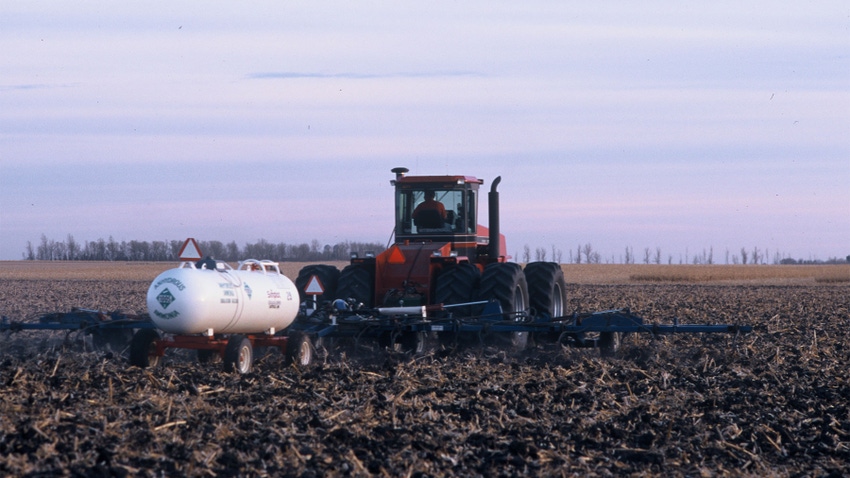
Getting the crop off to a good start can start in the fall with fertilization application.
Darrin Roberts, Nutrien Ag Solutions regional agronomy manager in Sioux Falls, S.D., offers tips for producers looking to apply the “big three” of nitrogen, phosphorus and potassium.
1. Pay attention to soil temperatures. “What we’re really looking for is for that soil temperature to be 50 degrees [F] and trending cooler for our nitrogen applications,” he says. “The reason being, we’re looking at the form of nitrogen that we’re putting down and how fast it’s going to transform from ammonium to nitrate.”
In cooler soils, he adds, microbial activity is slowed. “If we were in warmer soil conditions, that transformation might occur over a couple of weeks going from ammonium to nitrate. But if we wait for the soil temps to cool down, then it’s going to extend that period out to 10 to 12 weeks — or perhaps even longer for that transformation to occur, and that’ll benefit us next spring with more nitrogen being available to the crop.”
2. Pay attention to soil moisture. While no one is a fan of the current drought situation, Roberts says that may be a good thing for fall nitrogen applications.
“We have seen it where really dry conditions, after fall nitrogen applications, that we don’t see a lot of loss, and the nitrogen is going to stay there for next spring,��” he says.
On the moisture flip side, Roberts says a wet fall can cause N loss, “if it ends up being really wet in the fall, which can be a concern if we’re not closing the soil behind that anhydrous knife, which means we’re losing that into the atmosphere.”
In a sort of “The Three Bears” scenario, the soil needs to be “just right.” Roberts says N lost to the atmosphere can also occur if the soil is “too dry and cloddy; we could be losing it as well through the space between the clods.”
3. Consider a nitrogen stabilizer. “Being able to retain that nitrogen in ammonium form for a longer period of time, to keep it from transforming over to the nitrate form and being lost more easily down through the soil profile,” Roberts says, is a good reason for turning to a stabilizer, with many options on the market.
Nitrapyrin has long been the go-to active ingredient, but new active ingredients such as Pronitridine are on the market, “so there are several different options that farmers can use for nitrification inhibitors,” he says. “The whole point is to inhibit the activity of the bacteria in the soil that are going to be converting the nitrogen from ammonium to nitrate.”
Roberts discourages producers from opting to simply apply more N rather than paying for a nitrogen stabilizer application.
“I say you can do that, but it’s not the best route to go,” he says, both from an economic and environmental aspect. “Once we are applying our nitrogen rates above the optimal nitrogen rate for a given field, we tend to see increased nitrogen in the tile lines, so from an environmental standpoint it doesn’t make sense. At the same time when the nitrogen rates are applied above the optimal rate, the ROI [return on investment] for those basically goes to zero. … The best route is trying to apply the optimal rate and then protecting it with the stabilizer.”
4. Test soils. “Base your applications on soil test recommendations,” Roberts says of soil tests, which should be done every two to four years. “And at the minimum, you should be putting down P and K based on crop removal rates based on your previous yields or projected yields — but ideally we would be following a build-and-maintain approach for P and K applications.”
Roberts stresses the importance of soil samples being consistent and representative of the area being sampled. “Consistency as far as the depth of samples and the number of samples we’re collecting, hopefully between 10 to 12 cores, to form a composite sample.”
Representative means that the gathered samples will result in a test that shows “what’s actually going on in the field,” he says.
Staying with the consistency theme, Roberts says producers should sample at the same time of the year, recommending postharvest. “I think most guys are doing it in the fall because of logistical reasons, where there might be a little bit more time to get it done then, and it gives them plenty of time to make applications before the next spring,” he says.
5. Safety first. “Particularly when working with anhydrous, make sure that you have the correct PPE [personal protective equipment], and following correct safety protocols,” he says. “Protect yourself. Thinking of how fall usually goes, people are in a rush to get fields harvested and then to get things tilled and to get applications made before freeze-up. Just make sure that we’re staying safe in all these different applications.”
Roberts suggests farmers reach out to their Nutrien Ag Solutions crop consultant, or other trusted crop adviser, to further discuss fall fertilizer applications. Another source of information can be the University of Minnesota’s Fertilizer Guidelines for Agronomic Crops in Minnesota, which has just been released after being updated for the first time since 2011.
About the Author(s)
You May Also Like






